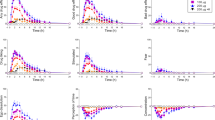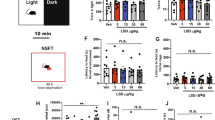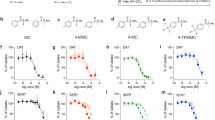Abstract
For more than 40 years the hallucinogen lysergic acid diethylamide (LSD) has been known to modify serotonin neurotransmission. With the advent of molecular and cellular techniques, we are beginning to understand the complexity of LSD's actions at the serotonin 5-HT2 family of receptors. Here, we discuss evidence that signaling of LSD at 5-HT2C receptors differs from the endogenous agonist serotonin. In addition, RNA editing of the 5-HT2C receptor dramatically alters the ability of LSD to stimulate phosphatidylinositol signaling. These findings provide a unique opportunity to understand the mechanism(s) of partial agonism.
Similar content being viewed by others
Log in or create a free account to read this content
Gain free access to this article, as well as selected content from this journal and more on nature.com
or
References
Backstrom JR, Westphal RS, Canton H, Sanders-Bush E . (1995): Identification of rat serotonin 5-HT2C receptors as glycoproteins containing N-Linked oligosaccharides. Mol Brain Res 33: 311–318
Backstrom JR, Sanders-Bush E . (1997): Generation of anti-peptide antibodies against serotonin 5-HT2A and 5-HT2C receptors. J Neurosci Methods 77: 109–117
Barker EL, Westphal RS, Schmidt D, Sanders-Bush E . (1994): Constitutively active 5-hydroxytryptamine2C receptors reveal novel inverse agonist activity of receptor lignads. J Biol Chem 269: 11687–11690
Berg KA, Maayani S, Clarke WP . (1996): 5-hydroxytryptamine2C receptor activation inhibits 5-hydroxytryptamine1B-like function via arachadonic acid metabolism. Mol Pharmacol 50: 1017–1023
Berg KA, Maayani S, Goldfarb J, Scaramellini C, Leff P, Clarke WP . (1998): Effector pathway-dependent relative efficacy at serotonin type 2A and 2C receptors: Evidence for agonist-directed trafficking of receptor stimulus. Mol Pharmacol 54: 94–104
Burns CM, Chu H, Rueter SM, Hutchinson LK, Canton H, Sanders-Bush E, Emeson RB . (1997): Regulation of serotonin-2C receptor G-protein coupling by RNA editing. Nature 387: 303–308
Burris KD, Breeding M, Sanders-Bush E . (1991):(+)Lysergic acid diethylamide, but not its nonhallucinogenic congeners, is a potent serotonin 5-HT1C receptor agonist. J Pharmacol Exp Ther 258: 891–896
Egan CT, Herrick-Davis K, Miller K, Glennon RA, Teitler M . (1998): Agonist activity of LSD and lisuride at cloned 5HT2A and 5HT2C receptors. Psychopharmacology 136: 409–414
Gaddum JH . (1953): Antagonism between lysergic acid diethylamide and 5-hydroxytryptamine. J Physiol (London) 121: 15P
Grotewiel MS, Chu H, Sanders-Bush E . (1994): m-chlorophenylpiperazine and m-trifluoromethylphenylpiperazine are partial agonists at cloned 5-HT2A receptors expressed in fibroblasts. J Pharmacol Exp Ther 271: 1122–1126
Hoyer D, Clarke DE, Fozzard JR, Martin GR, Mylecharane EJ, Saxena PR, Humphrey PP . (1994): International union of pharmacology classification of receptors for 5-hydroxytryptamine (serotonin). Pharmacol Rev 46: 157–203
Kaufman MJ, Hartig PR, Hoffman BJ . (1995): Serotonin 5-HT2C receptor stimulates cyclic GMP formation in choroid plexus. J Neurochem 64: 199–205
Krebs-Thomson K, Paulus MP, Geyer MA . (1998): Effects of hallucinogens on locomoter and investigatory activity and patterns: Influence of 5-HT2A and 5-HT2C receptors. Neuropsychopharmacology 18: 339–351
Krupnick JG, Benovic JL . (1998): The role of receptor kinases and arrestins in G protein-coupled receptor regulation. Annu Rev Pharmacol Toxicol 38: 289–319
Lucaites VL, Nelson DL, Wainscott DB, Baez M . (1996): Receptor subtype and density determine the coupling repertoire of the 5-HT2 receptor subfamily. Life Sci 59: 1081–1095
Marek GJ, Aghajanian GK . (1996): LSD and the phenethylamine hallucinogen DOI are potent agonists at 5-HT2A receptors on interneurones in rat piriform cortex. J Pharmacol Exp Ther 278: 1373–1382
Marek GJ, Aghajanian GK . (1998): Indoleamine and the phenethylamine hallucinogens: Mechanisms of psychotomimetic action. Drug Alcohol Depend 51: 189–198
Niswender CM, Copeland SC, Herrick-Davis K, Emeson RB, Sanders-Bush E . (1999): RNA editing of the human serotonin 5-hydroxytryptamine 2C receptor silences constitutive activity. J Biol Chem 274: 9472–9478
Niswender CM, Sanders-Bush E, Emeson RB . (1998): Identification and characterization of RNA editing events within the serotonin 5-HT2C receptor. NY Acad Sci 861: 38–48
Pawson T, Scott JD . (1997): Signaling through scaffold, anchoring, and adaptor proteins. Science 278: 2075–2080
Sanders-Bush E, Burris KD, Knoth K . (1988): Lysergic acid diethylamide and 2,5-dimethoxy-4-methylamphetamine are partial agonists at serotonin receptors linked to phosphoinositide hydrolysis. J Pharmacol Exp Ther 246: 924–928
Sanders-Bush E, Canton H . (1995): Serotonin receptors: Signal transduction pathways. In Bloom FE, Kupfer DJ (eds), Psychopharmacology: The Fourth Generation of Progress. New York, Raven Press, Ltd., pp 431–441
Simpson L, Emeson RB . (1996): RNA editing. Annu Rev Neurosci 19: 27–52
Titeler M, Lyon RA, Glennon RA . (1988): Radioligand binding evidence implicates the brain 5-HT2 receptor as a site of action for LSD and phenylisopropylamine hallucinogens. Psychopharmacology 94: 213–216
Wooley DL, Shaw E . (1954): A biochemical and pharmacological suggestion about certain mental disorders. Proc Natl Acad Sci 40: 228–231
Acknowledgements
Supported by the National Institutes of Health Research Grants MH34007, DA05181, and NS3589 (ESB); the National Alliance for Research on Schizophrenia and Depression (JB) and the American Epilepsy Society with support from the Lennox Fund (JB); the National Defense Medical Center, Taipei, Taiwan (HC); and the Pharmaceutical Manufacturers Association Foundation, Inc. (CMN).
Author information
Authors and Affiliations
Rights and permissions
About this article
Cite this article
Backstrom, J., Chang, M., Chu, H. et al. Agonist-Directed Signaling of Serotonin 5-HT2C Receptors: Differences Between Serotonin and Lysergic Acid Diethylamide (LSD). Neuropsychopharmacol 21 (Suppl 1), 77–81 (1999). https://doi.org/10.1016/S0893-133X(99)00005-6
Received:
Revised:
Accepted:
Issue date:
DOI: https://doi.org/10.1016/S0893-133X(99)00005-6



